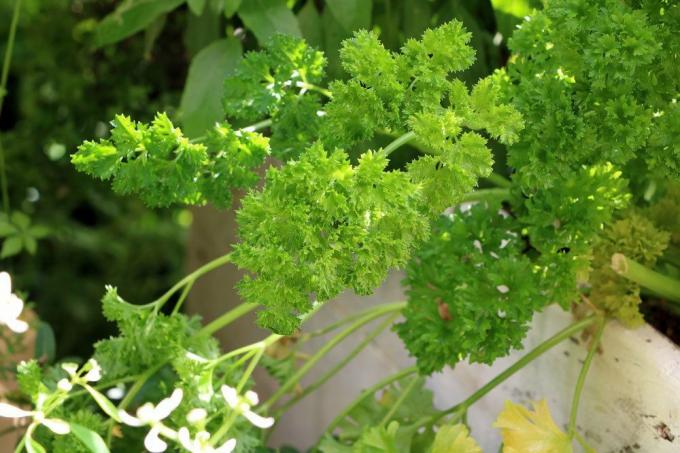
table of contents
- causes
- The right location
- The right substrate
- Appropriate watering
- Diseases and pests
- Different types of yellowing
Parsley (Petroselinum crispum) gives the food the decisive aroma - especially if it comes from home-grown. The tasty herb can be cultivated both in the bed and in the pot on the windowsill. Unfortunately, the plant is considered very idiosyncratic in terms of location and care. What to do if the parsley suddenly turns yellow and are the leaves still edible?
causes
If the parsley turns yellow from the pot, this is often due to incorrect care. The herb places high demands on compliance with the right conditions and reacts very sensitively to even the smallest discrepancies. If the gardener notices a change in the color of the leaves, he should check the following factors and improve them if necessary:
- unfavorable location conditions
- incorrect pouring behavior
- Diseases and pests
The right location
Unlike Mediterranean herbs, parsley feels good in partial shade. Too warm and sunny locations quickly cause sunburn on the leaves. This could be one of the reasons for the yellow color of the parsley. Especially when the gardener cultivates the plants in the pot on the windowsill, the glass pane intensifies the heat of the sunlight.
Tip: The gardener should take parsley from the supermarket from the plastic tray and transplant the herbs into a larger pot. This guarantees a longer freshness. Alternatively, he puts the plant directly in the bed.
The right substrate
The herb does not tolerate waterlogging. The soil should therefore be as loose and permeable as possible. In addition, a humus-rich substrate promotes growth by optimally supplying the parsley with the necessary nutrients that the plant needs in large quantities. The gardener must pay particular attention to this feature when keeping them in the balcony box. If he replanted it every year, the crop rotation is highly relevant. The gardener builds for years Umbelliferae in one and the same flower box, the earth will soon be drained. After harvesting the parsley, he must therefore completely renew the pot before planting Petroselinum crispum in the following year. In addition to parsley are also included
- carrot
- dill
- and fennel
to the umbelliferae.
Note: If the gardener can rule out a wrong location as the cause, a molybdenum or magnesium deficiency in the substrate often causes the yellow color of the parsley. A special indication for this reason are initially white spots on the leaves before the plants turn completely yellow. The gardener can obtain fertilizers specially designed for this deficiency in specialist shops.

Appropriate watering
The watering requires a lot of dexterity. It is important to find the right balance between soil that is not too dry and not too wet. The finger test can help here. Only when the top substrate layer is completely dry does the next watering take place. However, a dry period that is too long must not occur. Gardeners often forget that the irrigation water accumulates in the saucer, although there is a drainage system. When cultivating on the windowsill, the gardener must necessarily pour off excess water.
Warm tap water is best for watering in order to meet the preference for calcareous soil.
Diseases and pests
It is not uncommon for the leaves of the parsley to turn yellow and even has its own name. Botanists also speak of parsley disease. Umbelliferae are particularly susceptible to pests such as
- Root lice
- Nematodes
- Fungal spores
- Maggots
Most of the time, the vermin nest in the substrate and feed on the roots. The tiny pests are barely visible to the human eye. If there is no adequate crop rotation, the parasites multiply all the more.
Such a case of illness can be prevented if the gardener does not sow the parsley until August. At this time of year the pests have long since withdrawn. Plants that the gardener prefers in nursery pots are usually more robust against the parasites.
Note: A compost heap in the garden is all well and good, as the gardener can always get fresh, organic fertilizer from it. In this case, however, he should only use potting soil from specialist retailers for his pots. Decomposed material from the compost heap could contain pests in the first place.
Different types of yellowing
The leaves do not always turn yellow throughout. Stains or shades of color are also possible. These provide important information about which illness or which care mistake it is.

- Leaves turn completely yellow: dryness, waterlogging or encrusted soil, measure: change care habits
- yellow spots or light green or white mosaic pattern: infection with the parsley Y virus caused by aphids, measure: remove yellow shoots, do not dispose of on the compost
- weak yellow or white coloring of the leaves, sometimes with a reddish tinge: Infection with various types of viruses, often necrosis, can occur in too later treatment will lead to the death of the entire plant, measure: remove all infected shoots generously, not on the compost dispose
Is yellow parsley still edible?
Although the discoloration of the leaves also reduces the visual effect, the gardener usually grows the herb for consumption. So the question arises whether yellow parsley is still edible.
Generally there is no health risk. In the first place, only the taste suffers. The leaves lose their fresh aroma and taste bland and dry. If pests are the cause, the shoots can also start to rot. In this case, consumption is not recommended.
If the plant has withered, however, it is no longer suitable for culinary use. After flowering, parsley forms the toxic substance apiol, which not only makes the leaves inedible but also has health effects.



